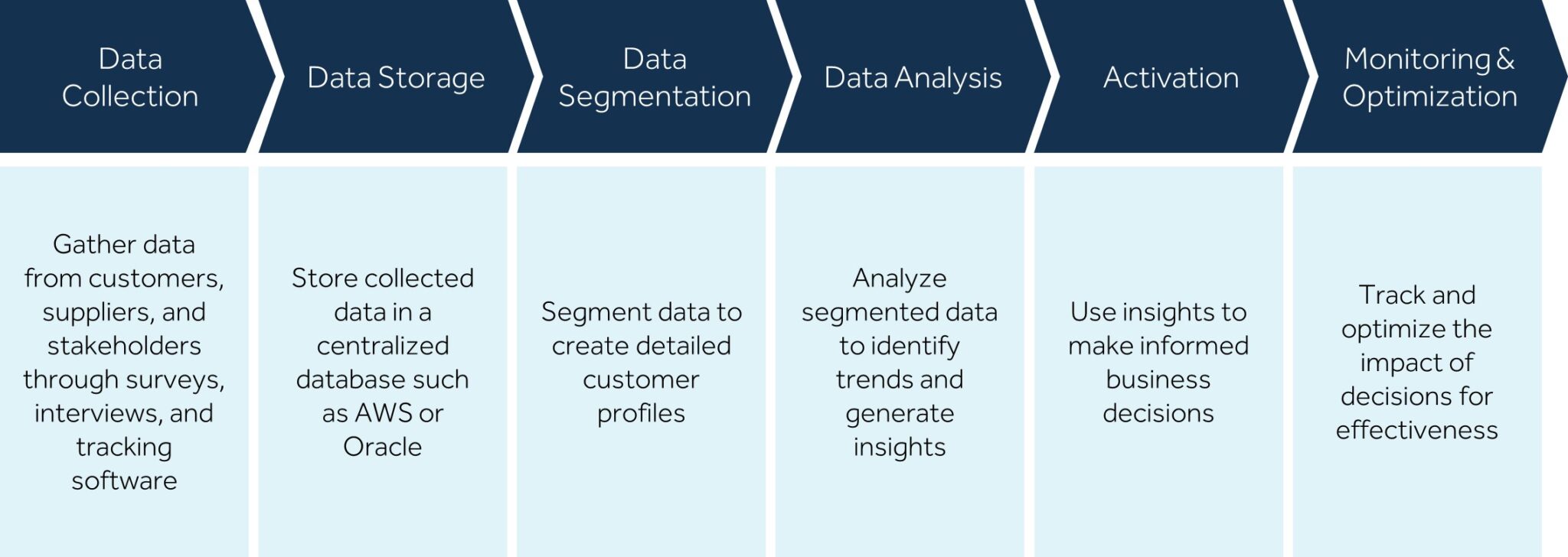
Understanding First-Party Data: A Strategic Asset in Business Development
First-party data is critical information that businesses collect directly from their interactions with customers. This data is sourced through various channels, including website interactions, Customer Relationship Management (CRM) systems, feedback forms, social media engagements, and direct customer interactions at events. As the most authentic form of data a company can access, first-party data provides invaluable insights into customer behaviors and preferences.
This type of data is a cornerstone for creating highly targeted marketing strategies and sophisticated business development initiatives. It allows companies to understand deeply and predict customer needs and preferences, enabling personalized customer experiences that drive engagement and loyalty. In the digital age, where business dynamics are continuously evolving, the strategic importance of first-party data cannot be overstated. Leading global companies such as Amazon, Google, Netflix, and Meta have harnessed the power of first-party data to achieve market dominance by offering tailored experiences that resonate with their user base.
How First-Party Data is Leveraged

Case Study: Netflix’s Strategic Use of First-Party Data
Netflix’s rise to a global powerhouse in the streaming industry is significantly attributed to its strategic utilization of first-party data. Netflix’s utilization of first party data from the early stages of the company makes them a frontrunner in content personalization and customer engagement. The Netflix FPD approach:
-
Data Collection:
Netflix collects extensive data on user interactions, including viewing choices, watch times, and behaviors like pausing or rewatching content. This granular data collection is pivotal in understanding nuanced user preferences and viewing habits.
-
Data Storage:
Utilizing robust cloud platforms like Amazon Web Services (AWS) S3, Netflix efficiently manages vast datasets, ensuring scalable and accessible data storage solutions that support real-time data processing and analysis.
-
Data Segmentation:
By categorizing data based on various parameters—geographic location, device usage, viewing patterns, and content interactions—Netflix crafts personalized viewing experiences. This segmentation is critical in tailoring content recommendations to individual tastes.
-
Data Analysis:
Advanced algorithms analyze the segmented data to detect trends and patterns, enhancing the precision of content recommendations. This analysis is key to engaging users by aligning viewing suggestions with their preferences.
-
Activation:
Insights derived from data analysis drive Netflix’s recommendation engines, offering personalized content suggestions that enhance user satisfaction and engagement, leading to higher retention rates.
-
Continuous Monitoring and Optimization:
Netflix constantly evaluates the effectiveness of its algorithms through techniques like A/B testing, ensuring that recommendations stay relevant and impactful. This ongoing optimization process adapts to evolving user data and preferences, maintaining a dynamic and responsive content delivery system.
By integrating first-party data across these strategic areas, Netflix not only enhances its service offerings but also secures a competitive edge in the rapidly evolving digital landscape. This case study exemplifies the potential of first-party data to revolutionize business practices and foster sustained industry leadership.
Case Study: Ferrari’s Strategic Use of First-Party Data for F1 Innovation
Scuderia Ferrari’s Formula 1 racing division has exemplified the transformative power of first-party data in enhancing F1 vehicle performance. Through the strategic deployment of advanced technologies and data analytics, Ferrari has achieved significant advancements in vehicle testing and race-day strategy, dramatically reducing costs while boosting performance metrics.
-
Data Collection and Analysis:
Ferrari harnesses a vast array of first-party data collected directly from their vehicles during tests and races. This data includes detailed telemetry information such as speed, tire pressure, engine performance, and aerodynamics. Using high-performance computing platforms, such as those provided by AWS, the team analyzes this data to glean insights into vehicle behavior and performance under various conditions.
-
Augmented AI and Sensor Technology:
In a pioneering move, Ferrari replaced traditional ground speed sensors with AI-enhanced sensors developed in collaboration with AWS. These sensors are lighter and less expensive, contributing to a reduction in overall vehicle weight and cost. Moreover, they provide real-time data that is more accurate, enabling immediate adjustments to vehicle settings and race strategy.
-
Hybrid Cloud Solutions and Data Storage:
Utilizing AWS’s hybrid cloud solutions, Ferrari efficiently manages the vast data sets generated during races. This approach allows for rapid data access and analysis, enabling the engineering team to make informed decisions quickly. The hybrid cloud infrastructure supports scalability and security, ensuring that sensitive performance data is protected yet readily accessible.
-
Edge Computing for Real-Time Decision Making:
By implementing edge computing solutions, Ferrari processes critical data directly at the racetrack. This technology reduces latency, allowing for instant data analysis and decision-making during races. It ensures that strategies can be adapted in real-time based on live performance data, giving Ferrari an edge over competitors.
Future Trends of First Party Data
The landscape of first-party data is evolving rapidly, propelled by advancements in artificial intelligence and computing technologies. Businesses are poised to experience significant transformations in how they collect, process, and leverage data. Key trends shaping this evolution include augmented analytics, hybrid cloud solutions, and edge computing, each playing a pivotal role in enhancing data-driven decision-making and operational efficiency.
-
Augmented Analytics Utilizing ML & AI to Identify Insights:
This trend employs cutting-edge technologies such as Natural Language Processing (NLP), Machine Learning (ML), and Artificial Intelligence (AI) to automate and enhance data analytics processes. Augmented analytics makes advanced data analysis more accessible, streamlining data preparation, insight generation, and dissemination. These capabilities enable businesses to quickly derive actionable insights, making data more actionable and decision-making more informed.
-
Cost Reduction & Increased Security through Cloud Computing:
Combining the advantages of both public and private clouds, hybrid cloud solutions offer a balance of scalability, cost-effectiveness, and enhanced security. These solutions facilitate better data management through AI and ML optimization, providing centralized databases that improve data security and operational scalability. This approach is particularly beneficial for managing and processing large volumes of first-party data, allowing businesses to leverage cloud computing’s power while maintaining control over sensitive information.
-
Faster Analysis through Edge Computing:
By processing data closer to its source, edge computing minimizes latency and enhances data security, which is crucial for real-time analytics. This technology is increasingly important in contexts where immediate data processing is critical, such as in autonomous vehicles, healthcare monitoring, and industrial automation. Edge computing supports faster, more reliable decision-making by enabling near-instantaneous insights and responses, transforming industries that rely on immediate data analysis.
Where and How You Can Implement First Party Data
Implementing first-party data strategies transforms customer engagement by providing deep insights into consumer behavior. A systematic approach involving collection, storage, analysis, and monitoring of this data enables companies to create highly personalized customer experiences and make informed decisions. These strategies not only enhance targeted marketing efforts but also drive significant investment returns. The integration of advanced technologies like AI, hybrid cloud solutions, and edge computing further refines these data processes, ensuring businesses can adapt quickly and stay competitive. The proven success of industry leaders such as Netflix and Ferrari illustrate the transformative potential of first-party data, establishing it as an essential element for future innovation and industry growth.
References
- Segment (2024)
- Geeks for Geeks (2024)
- Dasity (2023)
- Wired. (2023)
- Sangfor (2022)
- Medium (2022)
- Markivis (n.d.)
- Google Cloud (n.d.)
Related articles

Gen Z Runs the Feed: TikTok, Insta & Beyond

Unlocking the Generative AI Era


